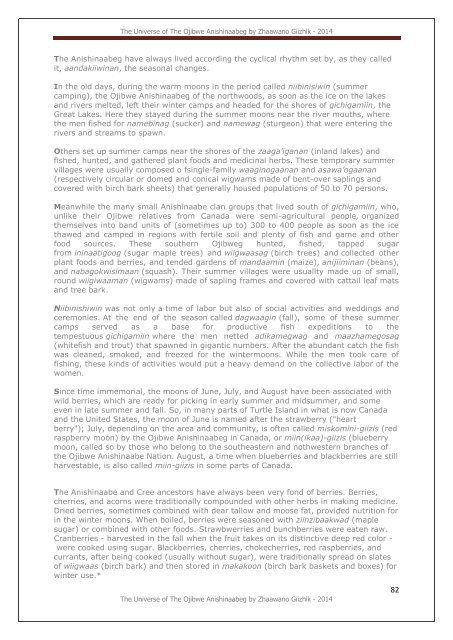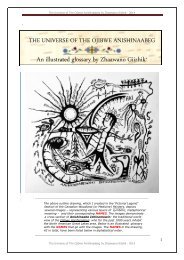The Universe Of The Ojibwe Anishinaabeg, an illustrated glossary by Zhaawano Giizhik*
A Glossary written and illustrated by Native Woodland artist Zhaawano Giizhik demonstrating a cross section of Anishinaabe Izhinamowin: the traditional worldview of the Ojibwe Anishinaabeg, who for the past 2 millennia inhabit the North American Great Lakes area.
A Glossary written and illustrated by Native Woodland artist Zhaawano Giizhik demonstrating a cross section of Anishinaabe Izhinamowin: the traditional worldview of the Ojibwe Anishinaabeg, who for the past 2 millennia inhabit the North American Great Lakes area.
You also want an ePaper? Increase the reach of your titles
YUMPU automatically turns print PDFs into web optimized ePapers that Google loves.
<strong>The</strong> <strong>Universe</strong> of <strong>The</strong> <strong>Ojibwe</strong> <strong>Anishinaabeg</strong> <strong>by</strong> Zhaaw<strong>an</strong>o Giizhik - 2014<br />
<strong>The</strong> <strong>Anishinaabeg</strong> have always lived according the cyclical rhythm set <strong>by</strong>, as they called<br />
it, a<strong>an</strong>dakiiwin<strong>an</strong>, the seasonal ch<strong>an</strong>ges.<br />
In the old days, during the warm moons in the period called niibinisiwin (summer<br />
camping), the <strong>Ojibwe</strong> <strong>Anishinaabeg</strong> of the northwoods, as soon as the ice on the lakes<br />
<strong>an</strong>d rivers melted, left their winter camps <strong>an</strong>d headed for the shores of gichigamiin, the<br />
Great Lakes. Here they stayed during the summer moons near the river mouths, where<br />
the men fished for namebinag (sucker) <strong>an</strong>d namewag (sturgeon) that were entering the<br />
rivers <strong>an</strong>d streams to spawn.<br />
Others set up summer camps near the shores of the zaaga’ig<strong>an</strong><strong>an</strong> (inl<strong>an</strong>d lakes) <strong>an</strong>d<br />
fished, hunted, <strong>an</strong>d gathered pl<strong>an</strong>t foods <strong>an</strong>d medicinal herbs. <strong>The</strong>se temporary summer<br />
villages were usually composed o fsingle-family waaginoga<strong>an</strong><strong>an</strong> <strong>an</strong>d asawa’oga<strong>an</strong><strong>an</strong><br />
(respectively circular or domed <strong>an</strong>d conical wigwams made of bent-over saplings <strong>an</strong>d<br />
covered with birch bark sheets) that generally housed populations of 50 to 70 persons.<br />
Me<strong>an</strong>while the m<strong>an</strong>y small Anishinaabe cl<strong>an</strong> groups that lived south of gichigamiin, who,<br />
unlike their <strong>Ojibwe</strong> relatives from C<strong>an</strong>ada were semi-agricultural people, org<strong>an</strong>ized<br />
themselves into b<strong>an</strong>d units of (sometimes up to) 300 to 400 people as soon as the ice<br />
thawed <strong>an</strong>d camped in regions with fertile soil <strong>an</strong>d plenty of fish <strong>an</strong>d game <strong>an</strong>d other<br />
food sources. <strong>The</strong>se southern <strong>Ojibwe</strong>g hunted, fished, tapped sugar<br />
from ininaatigoog (sugar maple trees) <strong>an</strong>d wiigwaasag (birch trees) <strong>an</strong>d collected other<br />
pl<strong>an</strong>t foods <strong>an</strong>d berries, <strong>an</strong>d tended gardens of m<strong>an</strong>daamin (maize), <strong>an</strong>ijiimin<strong>an</strong> (be<strong>an</strong>s),<br />
<strong>an</strong>d nabagokwisima<strong>an</strong> (squash). <strong>The</strong>ir summer villages were usuallty made up of small,<br />
round wiigiwaam<strong>an</strong> (wigwams) made of sapling frames <strong>an</strong>d covered with cattail leaf mats<br />
<strong>an</strong>d tree bark.<br />
Niibinishiwin was not only a time of labor but also of social activities <strong>an</strong>d weddings <strong>an</strong>d<br />
ceremonies. At the end of the season called dagwaagin (fall), some of these summer<br />
camps served as a base for productive fish expeditions to the<br />
tempestuous gichigamiin where the men netted adikamegwag <strong>an</strong>d maazhamegosag<br />
(whitefish <strong>an</strong>d trout) that spawned in gig<strong>an</strong>tic numbers. After the abund<strong>an</strong>t catch the fish<br />
was cle<strong>an</strong>ed, smoked, <strong>an</strong>d freezed for the wintermoons. While the men took care of<br />
fishing, these kinds of activities would put a heavy dem<strong>an</strong>d on the collective labor of the<br />
women.<br />
Since time immemorial, the moons of June, July, <strong>an</strong>d August have been associated with<br />
wild berries, which are ready for picking in early summer <strong>an</strong>d midsummer, <strong>an</strong>d some<br />
even in late summer <strong>an</strong>d fall. So, in m<strong>an</strong>y parts of Turtle Isl<strong>an</strong>d in what is now C<strong>an</strong>ada<br />
<strong>an</strong>d the United States, the moon of June is named after the strawberry ("heart<br />
berry"); July, depending on the area <strong>an</strong>d community, is often called miskomini-giizis (red<br />
raspberry moon) <strong>by</strong> the <strong>Ojibwe</strong> <strong>Anishinaabeg</strong> in C<strong>an</strong>ada, or miin(ikaa)-giizis (blueberry<br />
moon, called so <strong>by</strong> those who belong to the southeastern <strong>an</strong>d nothwestern br<strong>an</strong>ches of<br />
the <strong>Ojibwe</strong> Anishinaabe Nation. August, a time when blueberries <strong>an</strong>d blackberries are still<br />
harvestable, is also called miin-giizis in some parts of C<strong>an</strong>ada.<br />
<strong>The</strong> Anishinaabe <strong>an</strong>d Cree <strong>an</strong>cestors have always been very fond of berries. Berries,<br />
cherries, <strong>an</strong>d acorns were traditionally compounded with other herbs in making medicine.<br />
Dried berries, sometimes combined with dear tallow <strong>an</strong>d moose fat, provided nutrition for<br />
in the winter moons. When boiled, berries were seasoned with ziinzibaakwad (maple<br />
sugar) or combined with other foods. Strawbwerries <strong>an</strong>d bunchberries were eaten raw.<br />
Cr<strong>an</strong>berries - harvested in the fall when the fruit takes on its distinctive deep red color -<br />
were cooked using sugar. Blackberries, cherries, chokecherries, red raspberries, <strong>an</strong>d<br />
curr<strong>an</strong>ts, after being cooked (usually without sugar), were traditionally spread on slates<br />
of wiigwaas (birch bark) <strong>an</strong>d then stored in makakoon (birch bark baskets <strong>an</strong>d boxes) for<br />
winter use.*<br />
<strong>The</strong> <strong>Universe</strong> of <strong>The</strong> <strong>Ojibwe</strong> <strong>Anishinaabeg</strong> <strong>by</strong> Zhaaw<strong>an</strong>o Giizhik - 2014<br />
82





